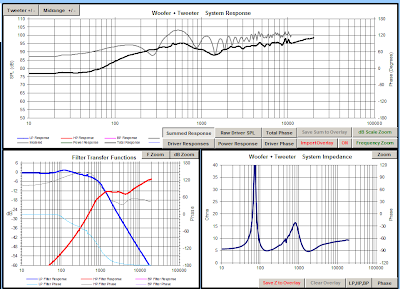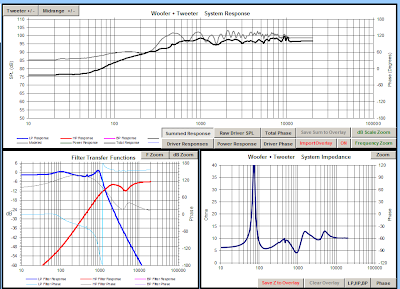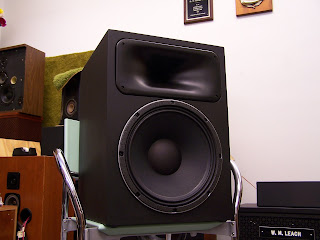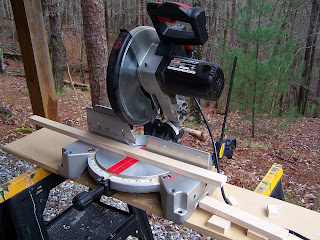Once the cabinets were completed, I set to designing the crossover, which I soon discovered was going to be a much more challenging task than I initially thought. My naive assumption that the physical crossover would perfectly match the modeled crossover was soon crushed, and I began the sometimes tedious, but mostly fun and interesting, process of designing and testing different crossover networks.
I quickly learned that the room I had available to me was going to present some problems since it is quite small, and not very well suited to the type of measurements I would be doing. With some help, I managed to get my measurements and clean them up in a way that gives me a reasonable idea of what's going on in the crossover region. Doing this required gating of the impulse response of the measurements, effectively removing the effects of signals delayed in time (mostly reflections that don't represent the direct signal from the speaker) at the cost of greatly reducing the frequency resolution of the data, and rendering the low frequency data (everything below about 250 Hz) useless, and unrepresentative of what's actually going on.
I started off with the design mentioned in the last post about the crossover that didn't take into account the acoustic offset derived from my previous measurements:
Omitting a small network on the tweeter's high pass filter, I was left with a fairly simple six component network that I was able to quickly prototype and implement in the finished cabinet. Below is the actual measured crossover from the above design:
As you can see, the actual crossover point is good deal lower than the modeled version, resulting in a more significant dip in the frequency response around the crossover point. On axis, this design doesn't actually look that terrible, despite the shifted crossover frequency, but with such a low crossover, the directivity of the woofer does not match that of the waveguide, resulting in poor off axis performance.
With my less than scientific documentation, I'm not entirely sure which crossover design the following screen captures represent, but I'm fairly certain they are a design very similar to the one shown above, but with the low pass filter altered to raise its cutoff frequency. It is the same kind of design, with a second order high pass on the tweeter, and a second order lowpass on the woofer, and it had similar behavior to the one pictured above, so I'll be using its measurements to show the off axis performance of the crossover.

The traces in the above picture, show the speaker at about 10 degree increments. Notice the large dips that appear at about 750 Hz and 1200 Hz as the microphone position moves further off axis. The null at 750 Hz has been present in other designs, and is possibly a result of reflections in the (less than ideal) room where I'm measuring, but the problem at 1200 Hz seems to be due to poor directivity and phase matching in the crossover region, which is possibly a result of the acoustic offset that I ignored for this particular design.
Even worse is the off axis performance in the vertical direction. When the microphone was placed between the tweeter and woofer, a huge null appeared, and was only slightly less at the woofer level.
The main point that these measurements seemed to suggest was that the acoustic offset of the two drivers is actually an issue, and not just an anomaly of the measurement setup I used to test the raw drivers. From this realization, I designed a very different crossover that took the offset into account, and ended up with better results.
This design uses a very simple first order high pass on the tweeter, and a third order low pass on the woofer, and manages to keep the crossover region flat in spite of the troubles caused by the acoustic offset of the drivers.
Shown above is the new design measured from varying heights. The response does get a little rocky around the crossover region, but it looks nothing like the deep null from the other design.
Next is the horizontal off axis response of this design. As you can see, the null at 750 Hz is back with a vengeance, but the next plot shows the off axis performance from a different area of the room, which all but removes the problem, leading me to believe it was just a result of the reflections in the room.
Overall I'm happy with the measured performance, and sound of this design, so it will likely be the final choice. However, I would still like to test in a large space (outside preferably) before ordering any parts. Also I need to implement a simple LCR circuit in the tweeter's high pass to knock down the small bump at about 4 kHz and see how that effects everything.
Until I can do those things, my next step is to build
Bwaslo's proven crossover and test that so I have something to compare to. This, above anything else, will help show if the acoustic offset is truly a problem, since it was designed without my particular offset in mind and should be flat if the offset doesn't exist. Additionally if it sounds good and measures well, I'll have an option if I decide to give up on this particular design and go with something already completed.












































